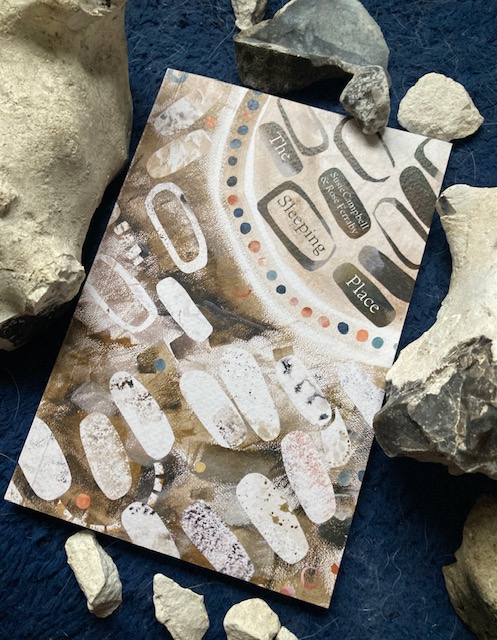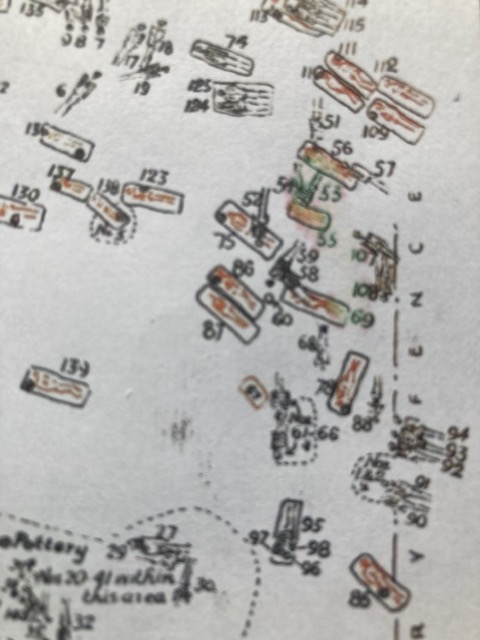
Reading from The Sleeping Place at the final launch
The series of launch events of The Sleeping Place (out now from Guillemot Press) culminated with an amazing event at Blackwell’s Bookshop Oxford, where I was joined by fellow poets Ruth Wiggins and Nancy Campbell, and artist-archaeologist Rose Ferraby. The tickets for this event sold out and so we had the pleasure of reading to a packed room. And just as I had hoped, the poetry readings were complemented by a talk on her creative process by Rose, and an inspiring discussion with the audience on the important role of poetry/creative responses within the archaeological record.

Ruth Wiggins, Nancy Campbell, Susie Campbell, Rose Ferraby at Blackwell’s Bookshop Oxford.
The Sleeping Place is well and truly ‘launched’! But after a launch, comes the voyage. Publishing is, for me, an opportunity to build a creative dialogue around the work and to engage in exploratory conversations. And so the launch is a prelude to the book finding its way to readers and to develop that conversation. Reviews and readers’ comments are therefore not just for publicising the book, but more importantly, they are about opening up the book to different readings and layers of meaning, keeping it open and unfinished, remade by each new reader.
Reviews
I am extremely grateful to those generous reviewers who have taken the trouble to read and comment on The Sleeping Place. I believe there are a few reviews still in the pipeline, but I was thrilled to see Stephen Sunderland’s insightful review for Mercurius Magazine here: https://www.mercurius.one/home/sn5ox3aktret1bfa9jhw62vhu4wf67
Stephen’s review was the first to appear and so I am particularly grateful to him and to Richard Capener, Reviews Editor. Another generous and perceptive review appeared in Long Poem Magazine by Anna Reckin. By lovely coincidence, Anna paired The Sleeping Place with Ruth Wiggins’ The Lost Book of Barkynge and explored the different approaches we each take to the deconstructions and reconstructions of history. Anna’s review is here: https://longpoemmagazine.org.uk/reviews/susie-campbell-the-sleeping-place-guillemot-2023-ruth-wiggins-the-lost-book-of-barkynge-shearsman-2023/
I was also inspired by Anna’s words to collage them with this image of chalk flints, so restless in The Sleeping Place, used to patch a pot-hole in the lane leading to the burial site.

Sealey Challenge
August saw many people embark on the Sealey Challenge to read a poetry book a day for the month, many focusing on the work of poets often overlooked by the mainstream. From their social media posts, I have compiled a wonderful reading list of recommendations and exciting finds. I was thrilled that a number of people included The Sleeping Place in their Sealey Challenge list, too many to list here, but I want to make a special thank you to Amanda Earl who kept up the challenge and read The Sleeping Place despite being admitted to hospital, and to Robert Frede Kenter whose poetic response inspired me to make this:

The conversations continue! I am looking forward to a number of events over the Autumn and Winter (Oxford, Reading and York) where I will be reading from The Sleeping Place. I have the great pleasure of working with Ruth Wiggins on a collaborative essay on ‘archival poetics’, and although I didn’t know Anna Reckin at all before her review, I now have an exciting opportunity to work on a collaborative performance with her. I have been invited to join PLaCE International, a member-owned research collective, which I hope will be a great forum for further discussion. My member page is here: https://www.placeinternational.co.uk/post/susie-campbell
and a featured conversation with me about ‘deep mapping’ and archaeological poetics in my work is here: https://www.placeinternational.co.uk/post/another-sense-of-deep-mapping-susie-campbell-s-the-sleeping-place
I am thrilled to say that The Sleeping Place is now into its second print run. Thank you to everyone who has supported this book. Copies available here but the second print run was only a small one and so it may be worth grabbing a copy now if you are planning to buy one: https://www.guillemotpress.co.uk/poetry/susie-campbell-the-sleeping-place
And finally, of course this blog is a great space for conversation and so thank you to all who read and share these posts. I leave you with this pertinent image of Bronze Age cordage – such strength once these fragile pieces are wound together!




































